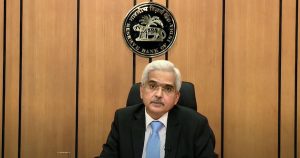 New Delhi: The Reserve Bank of India (RBI) on Friday (April 17) reduced the reverse repo rate by 25 basis points from four per cent to 3.75 per cent in a bid to inject liquidity in financial markets. However, the repo rate remains unchanged. This comes amid the COVID-19 pandemic and the subsequent countrywide lockdown.
New Delhi: The Reserve Bank of India (RBI) on Friday (April 17) reduced the reverse repo rate by 25 basis points from four per cent to 3.75 per cent in a bid to inject liquidity in financial markets. However, the repo rate remains unchanged. This comes amid the COVID-19 pandemic and the subsequent countrywide lockdown.
RBI Governor Shaktikanta Das said the liquidity injection has been 3.2 per cent of GDP since February 6 to March 27. “The RBI has been taking pro-active measures and monitoring the situation closely. The contraction in exports at 34.6 per cent has been much worse than 2008-09 global financial crisis,” Das said.
He said that India is expected to post a sharp turnaround by growing at 7.4 per cent in 2021-22. “For 2021-22, International Monetary Fund projects sizable reshaped recoveries, close to 9 percentage points for the global GDP. India is expected to post a sharp turnaround and resume its pre-COVID, pre-slowdown trajectory by growing at 7.4 per cent in 2021-22,” the RBI Governor said, adding that banks, financial institutions have risen to occasion to ensure normal functioning during the outbreak of the pandemic.
With regard to other measures, Das said RBI will begin with giving an additional Rs 50,000 crore through targeted long-term repo operation (TLTRO) to be undertaken in tranches. Besides, he announced a re-financing window of Rs 50,000 crore for financial institutions like Nabard, National Housing Bank and Sidbi.
He further said surplus liquidity in the banking system has increased substantially as a result of the central bank’s actions. Stating that the RBI is monitoring the situation developing out of COVID-19 outbreak, he noted that the contraction in exports in March at 34.6 per cent was much more severe than the global financial crisis of 2008-09. He said automobile production and sales declined sharply in March while electricity demand has fallen sharply.
He further said that by April 10, pre-monsoon kharif sowing had begun strongly, with acreage of paddy – the principal kharif crop – up by 37 per cent in comparison with the last season.
States such as West Bengal, Telangana, Odisha, Assam, Karnataka and Chhattisgarh are leading in sowing activity despite the lockdown. On April 15, the India Meteorological Department (IMD) forecast a normal south west monsoon for the 2020 season, with rainfall expected to be 100 per cent of the long period average.
“These early developments bode well for rural demand, supported as they are by accelerating fertiliser production up to February 2020,” Das said. The robust growth of 21.3 per cent in tractor sales up to February 2020 – as against a contraction of 0.5 per cent in April-February last year ? may provide an offset to farm labour shortages on account of the lockdown, he added. He, however noted the index of industrial production (IIP) for February showing that industrial output accelerated to its highest rate in seven months actually does not capture the impact of Covid-19.
Latest data on exports too has turned out to be much more severe than during the global financial crisis. The governor further said that in the period ahead, inflation could recede even further, barring supply disruption shocks and may even settle well below the target of 4 per cent by the second half of 2020-21.
“Such an outlook would make policy space available to address the intensification of risks to growth and financial stability brought on by COVID-19. This space needs to be used effectively and in time,” Das said.This is the RBI Governor’s second press briefing since the coronavirus COVID-19 outbreak began in India. In his previous address on March 27, he had announced a rate cut of 75 basis points.
Bureau Report
Leave a Reply